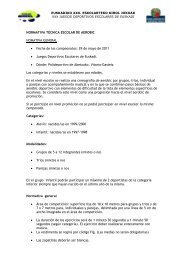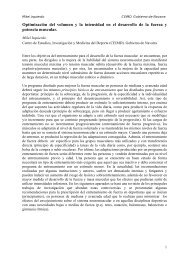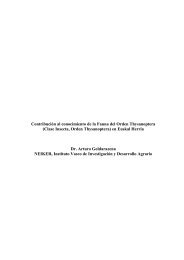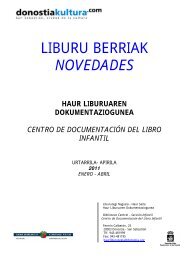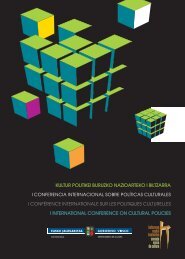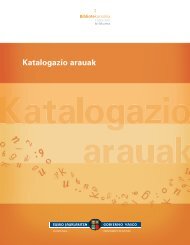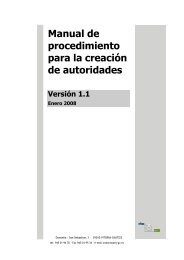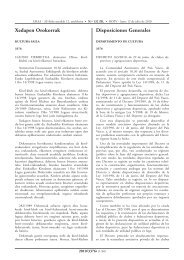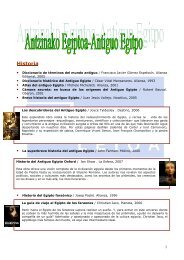The Basque Country (pdf, 4,3Mb) - Kultura Saila - Euskadi.net
The Basque Country (pdf, 4,3Mb) - Kultura Saila - Euskadi.net
The Basque Country (pdf, 4,3Mb) - Kultura Saila - Euskadi.net
Create successful ePaper yourself
Turn your PDF publications into a flip-book with our unique Google optimized e-Paper software.
8<br />
Traditional <strong>Basque</strong> farmhouse.<br />
1. GEOGRAPHY OF THE BASQUE<br />
COUNTRY–EUSKAL HERRIA<br />
<strong>The</strong> <strong>Basque</strong> <strong>Country</strong> runs along the 43rd parallel at the western<br />
edge of the Pyrenees Mountains, and is bathed by the Bay of Biscay<br />
(Cantabria Sea). This is where the <strong>Basque</strong> people have lived as a<br />
community for thousands of years. <strong>The</strong> <strong>Basque</strong>s and Lapps are<br />
thought to be survivors of the Upper Palaeolithic population and<br />
certainly predate the three so-called European types dating from the<br />
end of the Neolithic and early Bronze Age: Nordic, Mediterranean<br />
and Alpine. <strong>The</strong> <strong>Basque</strong>s have maintained their own language,<br />
Euskara, possibly the oldest language on the European continent.<br />
Euskal Herria covers a total surface area of 20,664 km 2 , and has a<br />
population of approximately three million. In short, it is a small ancient<br />
country with a strong identity and its own culture and history.<br />
<strong>The</strong> region enjoys a mild climate; extreme temperatures of either very<br />
hot or very cold are rare, although there is a fair amount of rainfall<br />
(2,000 mm annually in the more humid coastal zones and 500 mm<br />
along the Ebro River). <strong>The</strong>re are three different types of climate:<br />
subalpine in the area of the Pyrenees; Atlantic or temperate humid on<br />
the coast; and continental Mediterranean in the southern part of Araba<br />
and central and southern Navarre (hot summers, cold winters).<br />
<strong>The</strong>re are two clearly distinct watersheds: the Atlantic and the<br />
Mediterranean. Most of the population and industry is found<br />
in the Atlantic watershed (the north), while the Mediterranean<br />
watershed, bordered on the south by the Ebro River, is more<br />
agricultural and has smaller cities and towns.<br />
<strong>The</strong> northern part of Euskal Herria (Iparralde) occupies 15% of<br />
the total land area. <strong>The</strong> southern part (Hegoalde), which includes<br />
<strong>Euskadi</strong> and Navarre, occupies 85%.<br />
<strong>The</strong> French <strong>Basque</strong> <strong>Country</strong> does not have its own administrative<br />
unit. After the French Revolution it was incorporated in the French<br />
department of Pyrénées Atlantiques, together with the Bearn<br />
region. Today, most of Iparraldeʼs political parties and society<br />
demand a separate administrative region –Département du Pays<br />
<strong>Basque</strong>– limited to the French <strong>Basque</strong> <strong>Country</strong>.<br />
72 percent of the population of Euskal Herria lives in <strong>Euskadi</strong>; only<br />
19% lives in Navarre and 9% in Iparralde. With industrialisation at<br />
the end of the ni<strong>net</strong>eenth century many immigrants came to Bizkaia<br />
and Gipuzkoa, primarily from Castile, Navarre, Galicia, La Rioja and<br />
Extremadura. <strong>The</strong> 1950s and sixties saw another wave of immigration,<br />
which also affected Araba and Navarre. <strong>The</strong> population has grown<br />
very little in recent recers, although immigration at the beginning of<br />
the twenty-first century has given the population a new boost.<br />
Bizkaia<br />
Population: 1.122.637<br />
Area: 2.217 km 2<br />
Density: 506,4 hab/km 2<br />
Population: 673.563<br />
Area: 1.980 km 2<br />
Density:340,2 hab/km 2<br />
Gipuzkoa<br />
Álava-Araba<br />
Population: 286.397<br />
Area: 3.037 km 2<br />
Density: 94,3 hab/km 2<br />
CAV<br />
Population: 2.082.597<br />
Area: 7.234 km 2<br />
Density: 287.9 hab/km 2<br />
Source: EUSTAT.<br />
Population and<br />
surface area<br />
of <strong>Euskadi</strong>. 2001<br />
Between cities and rural villages,<br />
<strong>Euskadi</strong> also has a large number of<br />
mid-sized towns.<br />
University of Oñate, Gipuzkoa.



